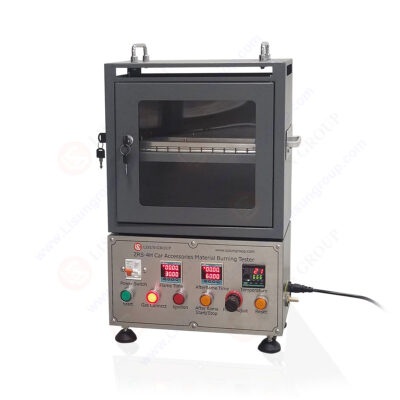
Analysis of Combustion Safety Performance of Automotive Interior Materials
Importance and Current Status
Combustion safety performance is a critical indicator for automotive interior materials. Typically, interior materials in vehicles are combustible, making stringent control over their combustion characteristics crucial. Currently, there are various standards governing the combustion characteristics of automotive interior materials, including internal standards set by large automotive manufacturers and national standards such as GB8410-2006 “Combustion Characteristics of Automotive Interior Materials.”
Overview of GB 8410-2006 Standard
GB8410-2006 “Combustion Characteristics of Automotive Interior Materials” is a mandatory standard in China for automotive interior components, applicable to all automotive interior materials. This standard does not equivalently adopt the U.S. Federal Motor Vehicle Safety Standard FMVSS 571.302. Since its implementation, GB8410-2006 has gained widespread recognition and serves as a primary basis for testing the combustion performance of domestically produced automotive interior materials. Its horizontal combustion test has become a mandatory inspection item for both suppliers and distributors of automotive interior components in China.
Impact and Application of the Standard
GB8410-2006 is not only widely used in the domestic automotive industry but was also designated as one of the first batch of compulsory certification (3C) testing items in China in 2003. The implementation of this standard has significantly enhanced the combustion safety performance of domestic automotive interior materials, thereby providing consumers with a safer driving environment.
Automotive Interior Material Burning Tester_ZRS 4H
Guide to Operating Automotive Interior Material Combustion Test Equipment
I. Equipment Preparation
• Installation Environment: Choose an installation environment for the test equipment that ensures good ventilation, is free from flammable materials, and maintains suitable temperature and humidity levels.
• Power Connection: Connect the test equipment to a stable and reliable power source, ensuring that the power voltage meets equipment requirements.
• Calibration and Inspection: Before use, calibrate and inspect the equipment to ensure the accuracy and normal operation of all parameters and sensors.
II. Operational Steps
• Sample Preparation: Prepare automotive interior material samples to be tested according to experimental requirements, and cut and prepare them to the dimensions and shapes specified by the standard.
• Sample Installation: Secure the samples onto the test bench, ensuring correct positioning and avoiding interference or contact between samples.
• Parameter Setting: Set the parameters of the test equipment according to experimental requirements and relevant standards, including the position of the ignition source, flame size, and test duration, to ensure the equipment conducts the test under appropriate conditions.
• Start Operation: Once all settings are confirmed correct, start the test equipment to initiate the test. During the test, closely monitor the combustion and smoke generation of the samples.
• Data Recording: Record key data during the test process, such as combustion time, combustion rate, and smoke density, to ensure the accuracy and completeness of the data.
• Result Analysis: Based on the test results, evaluate the combustion performance and smoke generation of the samples, and compare and analyze them against relevant standards.
III. Precautions
• Safety Operation: When using automotive interior combustion test equipment, follow safety operation procedures, wear personal protective equipment, and ensure the laboratory has appropriate safety facilities and emergency measures.
• Equipment Maintenance: Regularly clean the external and internal components of the equipment to keep it clean and tidy. Additionally, perform regular maintenance and calibration of the equipment to ensure its normal operation and accuracy.
• Sample Selection: Choose suitable samples for testing to ensure their representativeness and consistency. Also, ensure that sample sizes and shapes comply with standard requirements.
• Parameter Settings: According to experimental requirements and standard specifications, correctly set the parameters of the test equipment to ensure test repeatability and accuracy.
• Data Analysis: Conduct accurate data analysis and interpretation of test results, and assess and judge them in conjunction with relevant standards.
By adhering to these guidelines and standards, automotive manufacturers and testing laboratories can effectively evaluate and enhance the combustion safety performance of interior materials used in vehicles, contributing to safer and more reliable automotive interiors.
LISUN Automotive Interior Material Burning Tester consists of a testing section and a control section, adopting an integrated design for convenient on-site installation and debugging. The control system has a high degree of automation and features automatic ignition function. The temperature and time are displayed digitally, facilitating observation and recording, and ensuring stable and reliable operation.
Specifications:
• Test Gas Source: Gas or Liquefied Petroleum Gas (Suggestion: Use good quality gas if possible)
• Burner inner diameter: Ø9.5±0.5mm, about 100mm long with air adjusting hole
• Height of flame: Adjustable from 20 mm to 100 mm according to the standard requirement
• Applying time of flame: Burning time can be adjusted from 0 to 99 minutes 99 seconds
• Test process: Automatic control
• Inner volume: 0.05m³
• Material: Stainless steel or iron plate spray
• Power supply: AC 220V/5A; 50Hz
https://www.lisungroup.com/news/technology-news/automotive-interior-materials-burning-tester-user-guide.html
.jpg)
Comments
Post a Comment